First Aid In Urdu for Freacture
Download as pptx, pdf7 likes8,899 views
The document is a compilation by Syed Shakil Ahmed of 10 job completion notices (JCNs) for various jobs signed off by Mr. Zafar Iqbal at the JMCH. Each JCN provides information about the job number and is signed by the compiler, Syed Shakil Ahmed.
1 of 10
Downloaded 232 times
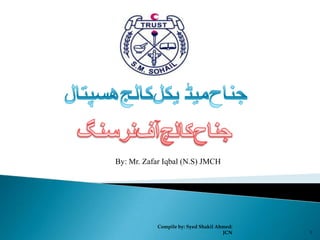
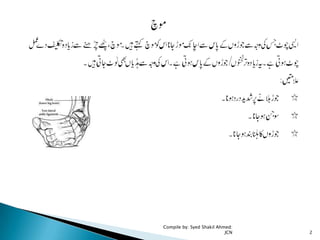

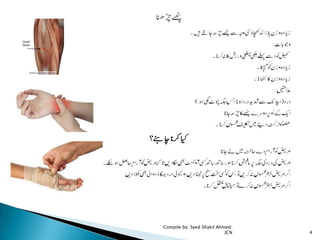
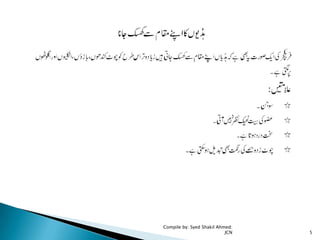
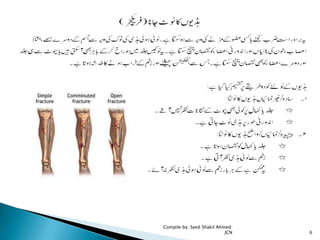
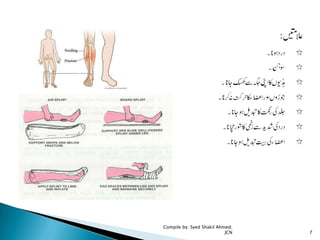
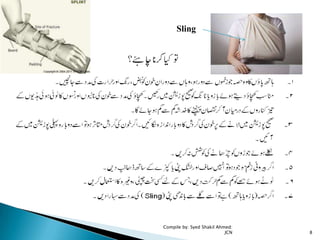
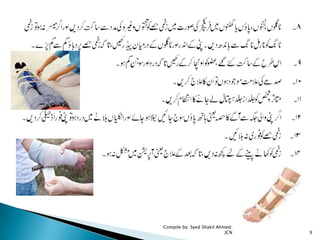
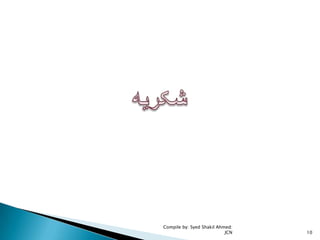
Ad
Recommended
First aid-heat-stroke in Urdu
First aid-heat-stroke in UrduSyed Shakil Ahmed
Ěý
In Urdu first time first aid for heat stroke and careFirst Aid in Urdu for Burns
First Aid in Urdu for BurnsSyed Shakil Ahmed
Ěý
This document contains 6 entries compiled by Syed Shakil Ahmed for different Job Creation Numbers (JCN) at the Jinnah Medical and Dental College Hospital (JMCH). Each entry lists the JCN followed by the compiler's name and the hospital name.First aid and_respiration
First aid and_respiration Adnan Masood
Ěý
The document is a guide on first aid and respiration, detailing various topics such as shock, skin burns, eye injuries, artificial respiration methods, and recovery positions. It includes stages of artificial respiration and instructions for specific emergencies like drowning and fractures. The publication was authored by Adnan Masood and released in July 2012.INFERTILITY & IT'S MANAGEMENT
INFERTILITY & IT'S MANAGEMENTAbhilasha verma
Ěý
The document presents an overview of female infertility, defined as the inability to achieve pregnancy after 12 months of unprotected intercourse. It covers types of infertility, etiology including male and female factors, risk factors, diagnostic investigations, and management strategies including lifestyle changes and assisted reproductive technologies (ART). Various ART methods such as IUI, IVF, GIFT, ZIFT, and ICSI are also discussed as options for addressing infertility.Infertility
InfertilityNikhil Vaishnav
Ěý
This document summarizes a seminar on male reproductive system disorders presented by Nikhil Vaishnav. It defines infertility as failure to conceive within one year of unprotected sex. There are two types of infertility - primary where couples have never conceived, and secondary where difficulty conceiving occurs after an initial conception. Infertility affects 1 in 7 couples and can be due to issues with sperm production, obstruction, ejaculation problems, or seminal fluid abnormalities in the male partner. Causes include genetic factors, infections, medications, lifestyle, and endocrine or structural abnormalities. Diagnosis involves medical history, exams, semen analysis, and hormone or genetic testing. Treatment focuses on improving general health, avoiding medications, using fertility drugs or therapiesGrowth and development
Growth and developmentDua FaTima
Ěý
The document summarizes theories of growth and development including Erikson's psychosocial development theory and Kohlberg's moral development theory. Erikson's theory outlines 8 stages of development from infancy to old age defined by psychosocial crises and the development of ego strengths. Kohlberg's theory describes 3 levels and 6 stages of moral reasoning development from obedience to rules to principled moral reasoning. The document also discusses factors influencing growth such as heredity, environment, intelligence and principles of development including continuity and predictability.Safety orientation urdu
Safety orientation urduRana Irfan Ali
Ěý
This document provides an overview of safety orientation topics, including:
- Defining HSE (health, safety, environment)
- Emphasizing the importance of safety and possible consequences of not following safety protocols
- Discussing personal protective equipment like helmets, shoes, glasses
- Defining near misses and promoting safe work conditions and compliance with relevant acts
- Guidance on specific safety hazards and protocols for excavation work, working at heights, use of chemicals, electricity, tools, cranes, lifting and more
- Promoting clean housekeeping, driving safety, and avoiding horseplay or fighting on site
- Stressing that safety is everyone's responsibility to protect lives and healthFirst aid ppt
First aid pptHarsh Khatri
Ěý
The document provides information on various first aid procedures. It discusses the objectives of first aid as preserving life, preventing worsening of conditions, and promoting recovery. It describes how to assess victims using DRABC (Danger, Response, Airway, Breathing, Circulation). Various first aid kits, treatments for burns, bleeding, fractures, snake bites, and more are outlined. The document emphasizes the importance of seeking immediate medical help when needed.Safety Posters
Safety Posters Adnan Masood
Ěý
Safety posters provide important safety information and reminders for employees. The manager of QHSE at The Chishtian Logistic, Adnan Masood, oversees safety posters. Contact information is provided should any questions arise regarding safety posters and their messages.Sharp objects presentation
Sharp objects presentationAna Metaxas
Ěý
The document provides tips for safely working with sharp objects and protecting hands from injuries. It discusses:
1. How to prevent puncture wounds through good housekeeping and being careful with power tools.
2. The proper first aid for puncture wounds and signs of infection to watch for.
3. Different types of gloves that can protect hands in various situations like disposable gloves, rubber gloves, leather gloves, and metal mesh gloves.
4. Additional hazards for hands like machinery, chemicals, heat/cold, electricity, and repetitive motions. It stresses using safety devices, guards, and disconnecting power before repairing equipment.Behavior based safety
Behavior based safetyAdnan Masood
Ěý
Behavior-based safety is a process that helps employees choose safe behaviors over unsafe ones through observation and feedback. It involves observing employees' behaviors, providing feedback on safe and unsafe behaviors, analyzing the data to measure improvements in safety over time, setting improvement goals, and reinforcing safe behaviors and goal attainment. When implemented successfully, it can result in increased efficiency, productivity, morale and profitability.Defensive driving
Defensive drivingSanjog Yadav
Ěý
This document discusses defensive driving techniques for commercial vehicles. It aims to help drivers recognize hazards, avoid accidents, safely operate and maintain their vehicles, and respond to emergencies. Some key points covered include common driving hazards like reckless or distracted drivers, fatigue, and road conditions. It provides tips for safe driving practices like scanning ahead, maintaining space between vehicles, and adjusting speed for conditions. Emergency response procedures are also outlined such as placing warning signals and calling for help if stopping on the roadside. The overall goal is to help commercial drivers prevent injuries and deaths through safe driving habits.House keeping in urdu
House keeping in urduFire Protection Association of Pakistan
Ěý
Housekeeping and fire safety procedures should be followed to minimize risks. Regular cleaning and waste disposal is important. Flammable materials must be properly stored away from heat sources and ignition points. Smoking restrictions and fire equipment maintenance helps prevent fires.Emergency Response Teams
Emergency Response TeamsThe Mead Group Inc.
Ěý
The Bay Area Emergency Managers Conference 2017 provided insights on emergency response teams (ERT), focusing on their composition, training, and operational frameworks for effective disaster management. Key discussions included the necessary equipment, recruitment strategies, and the importance of teamwork, communication, and regular training in building a culture of safety. The conference emphasized creating a structured approach to emergency incidents, underscoring the collaboration needed with local jurisdictions to ensure preparedness and response effectiveness.Defensive Driving Safety Training
Defensive Driving Safety TrainingGaurav Singh Rajput
Ěý
This document provides information on defensive driving techniques to help prevent vehicle accidents. It discusses key defensive driving strategies like planning ahead, being observant of others, anticipating errors, and showing consideration for other road users. Statistics on road accidents worldwide are presented. Common causes of accidents like speeding, tailgating, and driving under the influence are examined. The document also outlines driver responsibilities, vehicle safety checks, traffic rules, and steps to take in the event of an accident. The overall goal is to promote safe driving habits and help readers drive defensively to avoid collisions and injuries.Road safety ppt
Road safety pptAjeet Kumar
Ěý
The document outlines road safety training objectives which are to spread awareness of safe driving practices and work towards zero harm. It discusses understanding the major causes of accidents such as excessive speed, distractions, bad weather, and vehicle defects. Defensive driving techniques are covered including maintaining distance from other vehicles, anticipating errors from other drivers, and adjusting driving based on conditions. The document provides many tips for safe driving, loading, and operation of vehicles as well as precautions at intersections and when passing other vehicles.DEFENSIVE DRIVING FOR TRUCKS
DEFENSIVE DRIVING FOR TRUCKSSreenath Pokkadavath
Ěý
The document discusses the importance of defensive driving training for heavy transport drivers of TEKFEN CONSTRUCTION. It notes that the company had multiple accidents recently leading to property damage, injuries, and lost time. This training aims to help drivers identify hazards, understand defensive driving techniques, and use those techniques to prevent accidents and injuries. The objective is to drive safely and save lives, time, and money despite dangerous conditions or other drivers' actions.10 Forklift Safety Rules - A Review
10 Forklift Safety Rules - A ReviewCreative Safety Supply
Ěý
The document outlines essential forklift safety rules to enhance workplace safety, emphasizing safe speed, avoiding abrupt stops, and the importance of pedestrian right of way. Additional rules include restrictions on extra riders, proper fork positioning, and staying alert to environmental conditions like blind spots and floor hazards. Overall, adhering to these guidelines helps mitigate risks and maintain safety while operating forklifts.Behaviour based safety
Behaviour based safetyPrudhvi raj
Ěý
This document provides an overview of behavior-based safety. It defines key concepts like activators, behaviors, and consequences using the ABC model of behavior change. Unsafe behaviors, not incidents or injuries, are identified as the root cause of 96% of injuries. The power of consequences on behaviors is emphasized, with positive reinforcement being the most effective at increasing safe behaviors. A behavior-based safety program involves pinpointing critical behaviors, communicating expectations, conducting observations to provide feedback, and using data to reinforce safe behaviors and correct unsafe ones. The goal is to measure and modify behaviors to drive cultural and accident rate improvements over time.Loading and unloading white
Loading and unloading whiteLeavitt-University
Ěý
Loading and unloading machinery involves risks that must be assessed and mitigated. According to a document on loading and unloading procedures from 2005-2010 in Washington State, there were 12 fatal workplace incidents during loading or unloading, with forklifts and cranes involved in 6 cases. The document provides guidance on assessing hazards, communication, equipment inspection, and using spotters to load and unload safely. It emphasizes planning routes and controlling loads to prevent dropped equipment from causing damage, injuries or downtime.Ladder Safety
Ladder SafetyHvacmach
Ěý
The document discusses ladder safety, including types of portable ladders, ratings, selecting the appropriate ladder, proper use, maintenance and storage. It notes that most ladder injuries involve falls of less than 10 feet and recommends inspecting ladders regularly, setting them up correctly, and climbing/descending properly to reduce risks.Safety Culture
Safety Cultureguestbc6b08
Ěý
The document outlines the development and application of the Premac method by Persist Ltd. to enhance workplace safety through self-control and self-motivation among workers. It highlights the need for workers to take responsibility for their own safety behaviors rather than relying solely on external controls. The effectiveness of the Premac method, established since 1997, is supported by various case studies demonstrating its ability to reduce unsafe behaviors and improve self-awareness in workers.Working at heights
Working at heightsChitra Mohanty
Ěý
The document provides an overview of safety procedures for working at heights. It discusses ladder safety, fall protection equipment like harnesses and lanyards, scaffolding safety, and mobile elevated work platforms. It emphasizes the importance of fall protection, noting that falls are the leading cause of construction fatalities and that workers should be protected from falls of 2 meters or more.behavior based safety
behavior based safetyAhmed Mohammed Alhntoshi
Ěý
This document provides an overview of a behavioral-based safety observation program. It describes the basics of such a program, which involves employees recording safety observations of each other, with a focus on stopping unsafe work. The core aspects of the program are outlined, including observing behaviors, analyzing for safe and unsafe acts, providing feedback, and reporting observations. A seven-step process for conducting observations is also detailed, covering approaching employees, discussing hazards, agreeing on safer work methods, and documenting the interaction. The goals of the program are to increase hazard awareness and develop safer practices among employees.Forklift training
Forklift trainingPRAN-RFL Group
Ěý
Forklift training covers general forklift safety rules and procedures, operating instructions, potential hazards, and site-specific information. Only trained operators are permitted to drive forklifts. Training includes potential differences between forklifts and automobiles, pre-operation inspections, load capacity limits, fueling and maintenance procedures, and evaluation of operator skills. Retraining is required following accidents or changes in work duties or environment.Weekly ambulance checklist
Weekly ambulance checklistAzmeel Contracting Company
Ěý
This document contains a weekly ambulance checklist for Association of Abu-Nayyan, Azmeel & Saudi Tumpane dated [DATE]. It lists 47 items related to the general vehicle components, engine compartment, and underside that are inspected for an ambulance with Make [MAKE] and Model [MODEL]. The inspected ambulance is designated to Nurse Mahdi Ameen Jaffar and driven by Mr. Hilal Sha. The checklist notes the condition of each item as good, fair, needing repair, or not applicable. Signatures are included from the inspector, driver, nurse, and safety manager to acknowledge the inspection.Near miss presentation
Near miss presentationKyawKoKo13
Ěý
This presentation defines hazards, near misses, and accidents. It explains that a near miss is an undesired event that could have caused harm under different circumstances, while an accident actually causes injury or damage. Reporting and investigating near misses is important to identify causes and remove hazards before an accident occurs. Reducing near misses can predictably reduce accidents. The presentation encourages attendees to report any near misses to their company's health and safety department.Final first aid slides (presentation)
Final first aid slides (presentation)Corinna Daniela Chia
Ěý
This document provides an introduction to basic first aid, including how to treat minor injuries and medical emergencies. It explains that first aid aims to preserve life, prevent further injury, and promote recovery for a person in need of assistance. The document then gives guidance on treating specific first aid situations like nosebleeds, heart attacks, burns, and more. It also provides information on first aid training courses and resources in Singapore. General safety
General safety Fire Protection Association of Pakistan
Ěý
The document discusses general safety and occupational health and safety (OHS). It outlines that safety is everyone's responsibility, not just safety professionals. It also describes occupational health hazards like chemicals, physical hazards, and ergonomics issues. Key standards for health and safety are mentioned from organizations like OSHA, HSE, and ISO. Benefits of OHS include fewer injuries, higher productivity, and legal compliance. Safety depends on attitude, knowledge, and taking prompt action on hazards. Key elements of construction safety include personal protective equipment, hazard communication, fall protection, equipment operation safety, and electrical safety.More Related Content
What's hot (20)
Safety Posters
Safety Posters Adnan Masood
Ěý
Safety posters provide important safety information and reminders for employees. The manager of QHSE at The Chishtian Logistic, Adnan Masood, oversees safety posters. Contact information is provided should any questions arise regarding safety posters and their messages.Sharp objects presentation
Sharp objects presentationAna Metaxas
Ěý
The document provides tips for safely working with sharp objects and protecting hands from injuries. It discusses:
1. How to prevent puncture wounds through good housekeeping and being careful with power tools.
2. The proper first aid for puncture wounds and signs of infection to watch for.
3. Different types of gloves that can protect hands in various situations like disposable gloves, rubber gloves, leather gloves, and metal mesh gloves.
4. Additional hazards for hands like machinery, chemicals, heat/cold, electricity, and repetitive motions. It stresses using safety devices, guards, and disconnecting power before repairing equipment.Behavior based safety
Behavior based safetyAdnan Masood
Ěý
Behavior-based safety is a process that helps employees choose safe behaviors over unsafe ones through observation and feedback. It involves observing employees' behaviors, providing feedback on safe and unsafe behaviors, analyzing the data to measure improvements in safety over time, setting improvement goals, and reinforcing safe behaviors and goal attainment. When implemented successfully, it can result in increased efficiency, productivity, morale and profitability.Defensive driving
Defensive drivingSanjog Yadav
Ěý
This document discusses defensive driving techniques for commercial vehicles. It aims to help drivers recognize hazards, avoid accidents, safely operate and maintain their vehicles, and respond to emergencies. Some key points covered include common driving hazards like reckless or distracted drivers, fatigue, and road conditions. It provides tips for safe driving practices like scanning ahead, maintaining space between vehicles, and adjusting speed for conditions. Emergency response procedures are also outlined such as placing warning signals and calling for help if stopping on the roadside. The overall goal is to help commercial drivers prevent injuries and deaths through safe driving habits.House keeping in urdu
House keeping in urduFire Protection Association of Pakistan
Ěý
Housekeeping and fire safety procedures should be followed to minimize risks. Regular cleaning and waste disposal is important. Flammable materials must be properly stored away from heat sources and ignition points. Smoking restrictions and fire equipment maintenance helps prevent fires.Emergency Response Teams
Emergency Response TeamsThe Mead Group Inc.
Ěý
The Bay Area Emergency Managers Conference 2017 provided insights on emergency response teams (ERT), focusing on their composition, training, and operational frameworks for effective disaster management. Key discussions included the necessary equipment, recruitment strategies, and the importance of teamwork, communication, and regular training in building a culture of safety. The conference emphasized creating a structured approach to emergency incidents, underscoring the collaboration needed with local jurisdictions to ensure preparedness and response effectiveness.Defensive Driving Safety Training
Defensive Driving Safety TrainingGaurav Singh Rajput
Ěý
This document provides information on defensive driving techniques to help prevent vehicle accidents. It discusses key defensive driving strategies like planning ahead, being observant of others, anticipating errors, and showing consideration for other road users. Statistics on road accidents worldwide are presented. Common causes of accidents like speeding, tailgating, and driving under the influence are examined. The document also outlines driver responsibilities, vehicle safety checks, traffic rules, and steps to take in the event of an accident. The overall goal is to promote safe driving habits and help readers drive defensively to avoid collisions and injuries.Road safety ppt
Road safety pptAjeet Kumar
Ěý
The document outlines road safety training objectives which are to spread awareness of safe driving practices and work towards zero harm. It discusses understanding the major causes of accidents such as excessive speed, distractions, bad weather, and vehicle defects. Defensive driving techniques are covered including maintaining distance from other vehicles, anticipating errors from other drivers, and adjusting driving based on conditions. The document provides many tips for safe driving, loading, and operation of vehicles as well as precautions at intersections and when passing other vehicles.DEFENSIVE DRIVING FOR TRUCKS
DEFENSIVE DRIVING FOR TRUCKSSreenath Pokkadavath
Ěý
The document discusses the importance of defensive driving training for heavy transport drivers of TEKFEN CONSTRUCTION. It notes that the company had multiple accidents recently leading to property damage, injuries, and lost time. This training aims to help drivers identify hazards, understand defensive driving techniques, and use those techniques to prevent accidents and injuries. The objective is to drive safely and save lives, time, and money despite dangerous conditions or other drivers' actions.10 Forklift Safety Rules - A Review
10 Forklift Safety Rules - A ReviewCreative Safety Supply
Ěý
The document outlines essential forklift safety rules to enhance workplace safety, emphasizing safe speed, avoiding abrupt stops, and the importance of pedestrian right of way. Additional rules include restrictions on extra riders, proper fork positioning, and staying alert to environmental conditions like blind spots and floor hazards. Overall, adhering to these guidelines helps mitigate risks and maintain safety while operating forklifts.Behaviour based safety
Behaviour based safetyPrudhvi raj
Ěý
This document provides an overview of behavior-based safety. It defines key concepts like activators, behaviors, and consequences using the ABC model of behavior change. Unsafe behaviors, not incidents or injuries, are identified as the root cause of 96% of injuries. The power of consequences on behaviors is emphasized, with positive reinforcement being the most effective at increasing safe behaviors. A behavior-based safety program involves pinpointing critical behaviors, communicating expectations, conducting observations to provide feedback, and using data to reinforce safe behaviors and correct unsafe ones. The goal is to measure and modify behaviors to drive cultural and accident rate improvements over time.Loading and unloading white
Loading and unloading whiteLeavitt-University
Ěý
Loading and unloading machinery involves risks that must be assessed and mitigated. According to a document on loading and unloading procedures from 2005-2010 in Washington State, there were 12 fatal workplace incidents during loading or unloading, with forklifts and cranes involved in 6 cases. The document provides guidance on assessing hazards, communication, equipment inspection, and using spotters to load and unload safely. It emphasizes planning routes and controlling loads to prevent dropped equipment from causing damage, injuries or downtime.Ladder Safety
Ladder SafetyHvacmach
Ěý
The document discusses ladder safety, including types of portable ladders, ratings, selecting the appropriate ladder, proper use, maintenance and storage. It notes that most ladder injuries involve falls of less than 10 feet and recommends inspecting ladders regularly, setting them up correctly, and climbing/descending properly to reduce risks.Safety Culture
Safety Cultureguestbc6b08
Ěý
The document outlines the development and application of the Premac method by Persist Ltd. to enhance workplace safety through self-control and self-motivation among workers. It highlights the need for workers to take responsibility for their own safety behaviors rather than relying solely on external controls. The effectiveness of the Premac method, established since 1997, is supported by various case studies demonstrating its ability to reduce unsafe behaviors and improve self-awareness in workers.Working at heights
Working at heightsChitra Mohanty
Ěý
The document provides an overview of safety procedures for working at heights. It discusses ladder safety, fall protection equipment like harnesses and lanyards, scaffolding safety, and mobile elevated work platforms. It emphasizes the importance of fall protection, noting that falls are the leading cause of construction fatalities and that workers should be protected from falls of 2 meters or more.behavior based safety
behavior based safetyAhmed Mohammed Alhntoshi
Ěý
This document provides an overview of a behavioral-based safety observation program. It describes the basics of such a program, which involves employees recording safety observations of each other, with a focus on stopping unsafe work. The core aspects of the program are outlined, including observing behaviors, analyzing for safe and unsafe acts, providing feedback, and reporting observations. A seven-step process for conducting observations is also detailed, covering approaching employees, discussing hazards, agreeing on safer work methods, and documenting the interaction. The goals of the program are to increase hazard awareness and develop safer practices among employees.Forklift training
Forklift trainingPRAN-RFL Group
Ěý
Forklift training covers general forklift safety rules and procedures, operating instructions, potential hazards, and site-specific information. Only trained operators are permitted to drive forklifts. Training includes potential differences between forklifts and automobiles, pre-operation inspections, load capacity limits, fueling and maintenance procedures, and evaluation of operator skills. Retraining is required following accidents or changes in work duties or environment.Weekly ambulance checklist
Weekly ambulance checklistAzmeel Contracting Company
Ěý
This document contains a weekly ambulance checklist for Association of Abu-Nayyan, Azmeel & Saudi Tumpane dated [DATE]. It lists 47 items related to the general vehicle components, engine compartment, and underside that are inspected for an ambulance with Make [MAKE] and Model [MODEL]. The inspected ambulance is designated to Nurse Mahdi Ameen Jaffar and driven by Mr. Hilal Sha. The checklist notes the condition of each item as good, fair, needing repair, or not applicable. Signatures are included from the inspector, driver, nurse, and safety manager to acknowledge the inspection.Near miss presentation
Near miss presentationKyawKoKo13
Ěý
This presentation defines hazards, near misses, and accidents. It explains that a near miss is an undesired event that could have caused harm under different circumstances, while an accident actually causes injury or damage. Reporting and investigating near misses is important to identify causes and remove hazards before an accident occurs. Reducing near misses can predictably reduce accidents. The presentation encourages attendees to report any near misses to their company's health and safety department.Viewers also liked (18)
Final first aid slides (presentation)
Final first aid slides (presentation)Corinna Daniela Chia
Ěý
This document provides an introduction to basic first aid, including how to treat minor injuries and medical emergencies. It explains that first aid aims to preserve life, prevent further injury, and promote recovery for a person in need of assistance. The document then gives guidance on treating specific first aid situations like nosebleeds, heart attacks, burns, and more. It also provides information on first aid training courses and resources in Singapore. General safety
General safety Fire Protection Association of Pakistan
Ěý
The document discusses general safety and occupational health and safety (OHS). It outlines that safety is everyone's responsibility, not just safety professionals. It also describes occupational health hazards like chemicals, physical hazards, and ergonomics issues. Key standards for health and safety are mentioned from organizations like OSHA, HSE, and ISO. Benefits of OHS include fewer injuries, higher productivity, and legal compliance. Safety depends on attitude, knowledge, and taking prompt action on hazards. Key elements of construction safety include personal protective equipment, hazard communication, fall protection, equipment operation safety, and electrical safety.First Aid.Irfans Presentation
First Aid.Irfans Presentationaspdfsf
Ěý
The document presents information on first aid awareness and techniques. It discusses the aims of first aid as preserving life, preventing worsening of conditions, and promoting recovery. Emergency situations that may require first aid include car accidents, bleeding wounds, burns, bites, heart attacks, and electrical shocks. Basic first aid responses include calling for help, bringing help to the victim, checking ABCs (airway, breathing, circulation), and avoiding further harm. Specific first aid techniques are described for bleeding control, electrical shock, lack of breathing, fainting, heart attack, and snake bites. The importance of first aid kits and training is emphasized.Autonomous Maintenance Urdu
Autonomous Maintenance UrduFarid Ud Din
Ěý
CLIT is an acronym for Cleaning, Lubrication, Inspection, and Tightening, which are important maintenance procedures. The document outlines each part of the CLIT process, explaining why they are important and describing appropriate methods and tools for cleaning parts, applying lubrication, inspecting for issues, and ensuring proper tightening. It emphasizes the importance of regular CLIT maintenance to keep equipment functioning properly and provides resources like stickers and cards to track maintenance.Planning: Islamic perspective
Planning: Islamic perspectiveazeez luthfullah
Ěý
The document discusses the importance of planning (mansooba bandhi) in shaping the future and emphasizes the need for awareness of one's actions and their outcomes based on Islamic principles. It highlights key concepts such as foresight, proper communication, the significance of individual roles within a plan, and setting clear objectives to achieve desired results. The text also underscores the need for continuous questioning and evaluations to ensure that efforts align with the overarching goals defined by faith and societal needs.şÝşÝߣs first aid burns mgt
şÝşÝߣs first aid burns mgtEmeka Anugom
Ěý
The document provides information on first aid treatment for different types and degrees of burns. It discusses the common types of burns including thermal, electrical, chemical, and radiation burns. It describes how to classify burns as first, second, or third degree. First degree burns involve only the outer layer of skin, while second degree burns involve the outer two layers and third degree burns go deeper. The document outlines steps for managing different degrees of burns, including cooling the area, protecting it from infection, treating for shock, and knowing when to seek medical help.Management In Islam
Management In IslamSHAYA'A OTHMAN ORGANIZATIONAL BUSINESS MANAGEMENT
Ěý
This document discusses the Islamic concept of management. It states that Islam provides a complete way of life that guides how to act and behave in all aspects of life. It explains several principles of management that are derived from Islamic teachings in the Quran and hadith, including efficient use of resources, joint consultation, equal opportunities, motivation, and optimal capacity utilization. It gives examples of how modern management concepts are aligned with Islamic principles and how Toyota Motors implements some of these principles in their management philosophy.5S Urdu Training
5S Urdu TrainingFarid Ud Din
Ěý
This document outlines a 6 step process for organizing a workspace: 1) Red tag unnecessary items, 2) Restore available space, 3) Reduce inventory, 4) Ensure easy accessibility, 5) Create a feeling of comfort, and 6) Achieve a healthy change in outlook through sorting, setting locations, shining and sweeping, standardizing, and sustaining the new organization system. The overall aim is for teams to work together to organize and maintain their workspace.Firstaid
FirstaidFakha Shah
Ěý
This document provides an overview of first aid techniques for various common medical emergencies. It covers assessing consciousness, examining a casualty, treating wounds like cuts, abrasions and puncture wounds. It also outlines first aid protocols for bleeding, fractures, burns, performing CPR, treating shock, and assisting someone during an asthma attack. The key steps for conditions like bleeding and fractures involve not moving the casualty, splinting fractures, applying pressure to wounds and treating for shock. CPR involves tilting the head, pinching the nose, giving rescue breaths and chest compressions.Planning in islamic Organization
Planning in islamic OrganizationMohammad Yunus, MD, FACP
Ěý
The document emphasizes the importance of planning in the life of a Muslim, as exemplified by the Qur'an and the practices of the prophets, particularly Prophet Moses. It outlines various elements of planning, including setting goals, managing time, and personal development, while also highlighting the influence of Islamic teachings on strategic planning for both individuals and organizations. The text concludes with a framework for creating a personal development plan focused on spiritual, family, and societal responsibilities.Work place safety
Work place safetyKashaan Iftikhar
Ěý
The document consists of 20 pages that repeatedly provide instructions to click on a link to download a free green floral PowerPoint template. It also provides a link for more PowerPoint template presentations. The document promotes the download of a single PowerPoint template design over multiple pages.Basic Life Support & First Aid 2012
Basic Life Support & First Aid 2012Aaron Sparshott
Ěý
This presentation outlines basic life support principles based on the 2011 Australian guidelines, aimed at health students and applicable to anyone. It covers essential steps including checking for danger, responding to casualties, performing CPR, using defibrillators, and addressing specific emergencies such as bleeding, shock, and burns. The presenter emphasizes the importance of standard precautions in treating all patients, while clarifying that this presentation does not substitute for professional medical training.Health And Safety Induction Training
Health And Safety Induction Trainingedale07
Ěý
This document outlines health and safety topics covered in an induction training. It discusses hazards associated with working at heights, proper use of ladders and scaffolding, fall protection, machine safety, chemical hazards, traffic safety, fire safety, and more. Safety signage and their meanings are explained. Penalties for safety infractions are listed to encourage compliance with safety rules and regulations. The goal is to educate workers on best practices to avoid accidents and injuries on the jobsite.First aid
First aidMarygrace Cagungun
Ěý
The document provides information on various first aid procedures. It defines first aid as the initial response to medical emergencies by non-medical experts. The purposes of first aid are to sustain life, prevent suffering, avoid complications, and promote recovery. It describes do's and don'ts for first responders, principles of first aid using the 4 C's (call for help, take charge, check the scene and casualty, care for the casualty), and the DRABC action plan. It then provides guidance on treating common injuries and illnesses like nosebleeds, heart attacks, burns, choking, bites/stings, wounds, and potential spinal injuries. It concludes by listing recommended contents for a first aid kit.Basic first aid & cpr
Basic first aid & cprWilhelminareyes
Ěý
This document provides a summary of basic first aid procedures. It outlines the qualities of a first aider, including being calm, confident, willing to help, and patient. It describes how to preserve life by controlling bleeding, treating shock, and performing CPR if needed. It also explains how to prevent a condition from worsening by dressing wounds, providing comfort, and positioning the casualty. Finally, it discusses promoting recovery by relieving anxiety, encouraging trust, and handling the casualty gently.First aid & bandaging
First aid & bandaging Maybelle Animas
Ěý
1. First aid provides immediate care for illness or injury until medical help arrives to prolong life, alleviate suffering, and prevent further injury.
2. A first aid kit contains essential supplies like bandages, antiseptics, gloves, and splints.
3. Common injuries and illnesses requiring first aid include fainting, nosebleeds, wounds, fractures, and burns.
4. Proper first aid techniques include controlling bleeding, preventing infection, immobilizing injuries, and seeking further help if needed.How to Make Awesome şÝşÝߣShares: Tips & Tricks
How to Make Awesome şÝşÝߣShares: Tips & TricksşÝşÝߣShare
Ěý
The document outlines key strategies for optimizing content on şÝşÝߣshare to enhance online visibility and professional opportunities. It emphasizes the importance of creating engaging, visual content that appeals to the audience while leveraging SEO capabilities to increase discoverability. Additionally, it provides practical tips for repurposing existing content and maximizing social media reach to encourage virality.Getting Started With şÝşÝߣShare
Getting Started With şÝşÝߣShareşÝşÝߣShare
Ěý
şÝşÝߣShare is a global platform for sharing presentations, infographics, videos and documents. It has over 18 million pieces of professional content uploaded by experts like Eric Schmidt and Guy Kawasaki. The document provides tips for setting up an account on şÝşÝߣShare, uploading content, optimizing it for searchability, and sharing it on social media to build an audience and reputation as a subject matter expert.Ad
Recently uploaded (20)
Drmohamedaslam_resident_copd2025_fm.pptx
Drmohamedaslam_resident_copd2025_fm.pptxAslam
Ěý
COPD :LATEST GUIDELINES 2025
REFERENCE: Harrison’s Principles of Internal Medicine
GOLD -2025 Guidelines
It highlights updated diagnostic criteria, pharmacological and non-pharmacological treatment options, and current best practices for resident doctors and healthcare professionals.
Ideal for medical students, residents, and practitioners seeking an up-to-date, evidence-based reference.
👉 Download, share, and feel free to reach out for related study material!From Preservation To Regeneration--The Stem Cell Era of Hair Restoration_DrAl...
From Preservation To Regeneration--The Stem Cell Era of Hair Restoration_DrAl...Alan Bauman
Ěý
How can the latest in Regenerative Medicine help those suffering from hair loss? Cell Surgical Conference 2025 featured Dr Alan Bauman as a faculty member once again to discuss all things related to hair loss, hair transplantation and the use of regenerative stem cell therapies for hair restoration. Winning GAMBITS Against AML: Guidance on Advances & Medical Breakthroughs wit...
Winning GAMBITS Against AML: Guidance on Advances & Medical Breakthroughs wit...PVI, PeerView Institute for Medical Education
Ěý
Chair and Presenter, Naval Daver, MD, Jessica K. Altman, MD, and Ghayas Issa, MD, Alice S. Mims, MD, MSCR, discuss acute myeloid leukemia in this CME/MOC/AAPA/IPCE activity titled “Winning GAMBITS Against AML: Guidance on Advances & Medical Breakthroughs with Innovative Targeted Strategies.” For the full presentation, downloadable Practice Aids, and complete CME/MOC/AAPA/IPCE information, and to apply for credit, please visit us at https://bit.ly/42f1QCa. CME/MOC/AAPA/IPCE credit will be available until June 30, 2026.ELECTROMYOGRAPHY.pptX by GOKULAKRISHNAN.
ELECTROMYOGRAPHY.pptX by GOKULAKRISHNAN.GOKULAKRISHNAN JANARTHANAN
Ěý
Electromyography is basically the study of motor unit activity.
In electromyography, the study of the electrical activity of contracting muscle provides information concerning the structure and function of the motor units.
JUNE 2025 ONCOLOGY CARTOONS BY DR KANHU CHARAN PATRO
JUNE 2025 ONCOLOGY CARTOONS BY DR KANHU CHARAN PATROKanhu Charan
Ěý
JUNE 2025 ONCOLOGY CARTOONS BY DR KANHU CHARAN PATROOUR SRS SBRT EXPERIENCE BY DR KANHU CHARAN PATRO
OUR SRS SBRT EXPERIENCE BY DR KANHU CHARAN PATROKanhu Charan
Ěý
OUR SRS SBRT EXPERIENCE BY DR KANHU CHARAN PATROCoarse Dispersion, Physical Pharmaceutics
Coarse Dispersion, Physical Pharmaceuticsnishiprakashj
Ěý
Its a compilation of unit 3 as per PCI syllabus of B.Pharm IV sem, Subject Physical Pharmaceutics.Severe Acute Respiratory Syndrome (SARS)
Severe Acute Respiratory Syndrome (SARS)Dr. Anu Marhatta
Ěý
This slide is for educational purposes only. Quality by Design Tools in Pharmaceutical Manufacturing Technology
Quality by Design Tools in Pharmaceutical Manufacturing Technology39KomalZaveri
Ěý
In Qbd why risk assessment needed that explained
Design Space and DoE relationship with each other.
Yoga Postures to Practice
for Holistic (Physical, Mental, and Cognitive) Well...
Yoga Postures to Practice
for Holistic (Physical, Mental, and Cognitive) Well...Bhoj Raj Singh
Ěý
An ancient System for holistic health (mental and physical) and wellbeing, is a scientific art of living with harmony (connecting) of mind and body. Although much more ancient than Patanjali, who documented yoga systematically about 2000 years ago, Patanjali is often referred to as the "father of modern yoga."
Yoga postures are commonly depicted in ancient paintings, carvings, and sculptures in almost all civilizations and religions, thus Yoga can’t be described as an act of Hinduism. It originated long before any religion on Earth, with the emergence of life on the Planet. All yoga poses are natural, and what is not natural is not yoga; it isĚýViyoga.
Besides Vedic Yoga, Hatha, Vinyasa, Ashtanga, Iyengar, Yin, Restorative, Kundalini, Bikram, Sahaj, and Power yoga are some popular types.
VinyasaĚýYoga is the closest form to Vedic Yoga; it is known for its flowing movements, not very rigorous, not too much straining, actions flow with the breath.
Though all yoga may lead to meditation (Dhyan) for your inner upliftment, it is not the same as described in Hinduism for self-liberation.
In Hinduism, different paths of life looking distinct but can be practiced all together, they are: Karma Yoga (selfless action and service), Bhakti Yoga (devotion and love for God or Godly power), Jnana (Gyan) Yoga (gaining knowledge for self-realization through wisdom), Dhyan Yoga (meditation) and Kriya Yoga (optimum utilization of your vital and muscular energy).Ěý
Anesthetic Evaluation & Management in Pregnancy with APH.pdf
Anesthetic Evaluation & Management in Pregnancy with APH.pdfDr Anik Roy Chowdhury
Ěý
Dr. Anik Roy Chowdhury
MBBS, BCS (Health), DA, MD Resident
Shaheed Suhrawardy Medical College Hospital (ShSMCH)MAY 2025 ONCOLOGY CARTOONS BY DR KANHU CHARAN PATRO
MAY 2025 ONCOLOGY CARTOONS BY DR KANHU CHARAN PATROKanhu Charan
Ěý
MAY 2025 ONCOLOGY CARTOONS BY DR KANHU CHARAN PATROAn interesting case of facial Swelling in an autoimmune rheumatic disease Ahm...
An interesting case of facial Swelling in an autoimmune rheumatic disease Ahm...Internal medicine department, faculty of Medicine Beni-Suef University Egypt
Ěý
An interesting case of facial Swelling in an autoimmune rheumatic disease Ahmed Yehia EGYSIR Conference Patient-Centric Frameworks in Desmoid Tumors: Integrating Emerging Science on...
Patient-Centric Frameworks in Desmoid Tumors: Integrating Emerging Science on...PVI, PeerView Institute for Medical Education
Ěý
Co-Chairs, Prof. Dr. Patrick Schöffski, MPH, and Breelyn A. Wilky, MD, discuss desmoid tumors in this CME activity titled “Patient-Centric Frameworks in Desmoid Tumors: Integrating Emerging Science on Gamma Secretase Inhibitors for Progressive Disease.” For the full presentation, downloadable Practice Aids, and complete CME information, and to apply for credit, please visit us at https://bit.ly/4iDPUQY. CME credit will be available until June 29, 2026.nanoparticle and liposomes ppt .(NTDS)pdf
nanoparticle and liposomes ppt .(NTDS)pdfsiddhikalbande
Ěý
Nanoparticles and liposomes are advanced carriers used for targeted drug delivery.
Nanoparticles enhance drug effectiveness by directing treatment to specific sites.
Liposomes are biocompatible vesicles that enable controlled and sustained drug release.Navigating the Open Enrollment Period for Medicare Supplement Insurance in Sa...
Navigating the Open Enrollment Period for Medicare Supplement Insurance in Sa...dfwdirectinsurance
Ěý
Understanding Medicare options can feel like navigating a maze, especially during the open enrollment period. For residents of Sarasota approaching age 65 or already enrolled in Medicare, this window offers a vital opportunity to secure additional health coverage that helps reduce out-of-pocket costs. If you're planning to enhance your Medicare plan, it's essential to understand the rules, deadlines, and options that apply to Medicare supplement insurance in Sarasota.Winning GAMBITS Against AML: Guidance on Advances & Medical Breakthroughs wit...
Winning GAMBITS Against AML: Guidance on Advances & Medical Breakthroughs wit...PVI, PeerView Institute for Medical Education
Ěý
An interesting case of facial Swelling in an autoimmune rheumatic disease Ahm...
An interesting case of facial Swelling in an autoimmune rheumatic disease Ahm...Internal medicine department, faculty of Medicine Beni-Suef University Egypt
Ěý
Patient-Centric Frameworks in Desmoid Tumors: Integrating Emerging Science on...
Patient-Centric Frameworks in Desmoid Tumors: Integrating Emerging Science on...PVI, PeerView Institute for Medical Education
Ěý
Navigating the Open Enrollment Period for Medicare Supplement Insurance in Sa...
Navigating the Open Enrollment Period for Medicare Supplement Insurance in Sa...dfwdirectinsurance
Ěý
Ad
First Aid In Urdu for Freacture
- 1. Compile by: Syed Shakil Ahmed: JCN 1 By: Mr. Zafar Iqbal (N.S) JMCH
- 2. Compile by: Syed Shakil Ahmed: JCN 2
- 3. Compile by: Syed Shakil Ahmed: JCN 3
- 4. Compile by: Syed Shakil Ahmed: JCN 4
- 5. Compile by: Syed Shakil Ahmed: JCN 5
- 6. Compile by: Syed Shakil Ahmed: JCN 6
- 7. Compile by: Syed Shakil Ahmed: JCN 7
- 8. Compile by: Syed Shakil Ahmed: JCN 8 Sling
- 9. Compile by: Syed Shakil Ahmed: JCN 9
- 10. Compile by: Syed Shakil Ahmed: JCN 10
